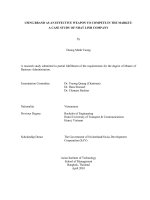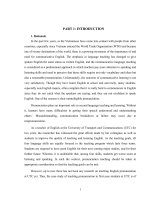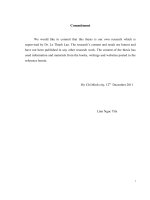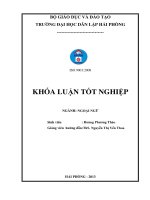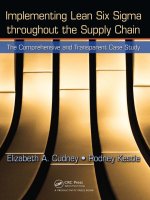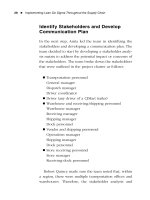The answer questions of case study of autozone inc corporate finance strategies
Bạn đang xem bản rút gọn của tài liệu. Xem và tải ngay bản đầy đủ của tài liệu tại đây (104.55 KB, 13 trang )
The Answer -questions of case
study of AutoZone InC
(Corporate Finance Strategies)
AUTOZONE
Q#1. How has AutoZone’s stock price performed
over the previous five years? What other financial
measures can you cite that are consistent with the
stock price performance?
AutoZone’s shareholders had enjoyed strong price appreciation since 1997, with an
average annual return of 11.5%. Over the previous five years, AutoZone’s stock price
has increased dramatically. On February 1. 2012 the stock price was $348 compared to
the $125 on February 1. 2007. The strong price appreciation resulted from several
occurrences; some of them are U.S.
economy recession and share repurchase program. Auto-part business was somewhat
counter-cyclical. Company’s growth and stock price were directly related to the economy
and number of miles a vehicle had been driven. As the age of car increased, more
repairs were required. Because of these reasons, AutoZone’s stock price was
significantly improving from 2008.
AutoZone’s financial statements reflect the stock price performance. Net sales have
increased for 30.85% from 2007 to 2011. Cost of sales also increased during that period,
but at lower rate of 27.30%, what helped in additional improvement of gross profit.
AutoZone’s increasing operating profit indicates the efficiency and profitability of the
company. Further, the
increase of operating profit led to the slight increase of operating margin, from 17.10% in
2007 to 18.52% in 2011. One financial measure that is strongly related to the stock price
performance is EPS. EPS, a key driver of stock price, have been increasing at an
extremely high rate. From 2007 to 2011, basic EPS have increased for 131%, and
diluted EPS have increased for
128%. Another important financial measure is PEG ratio. PEG ratio is been constantly
decreasing, which is a good sign for the company and investors. Decrease of PEG ratio
signals a greater value for AutoZone’s company, because its investors are going to pay
less for each unit of earnings growth. Here is a table of financial measures that are
related to the stock price:
STOCK PRICE
Aug.25,2007
Aug.30, 2008
Aug. 29,
2009
Aug.28, 2010
Aug.27,2011 EPS $120
$138
$149 $8.53
$10.04
$11.73 $211
$298 $14.97
$19.47 EPS
annual
growth
rate P/E RATIO PEG RATIO 17%
17% 13.92
13.61
12.53 0.80
0.73 28%
30% 13.85
14.97 0.49
0.50
AutoZone shareholders had enjoyed strong price appreciation over the previous 5
years (1997-2011), with an average annual return of 11.5%. The stock price stood at
$348 in the beginning of the year 2012. From the beginning, AutoZone had invested
heavily in expanding its retail footprint via both organic and inorganic growth.
In 2008, the U.S. economy had gone through the worst recession since the Great
Depression, and the recovery that followed had been unusually slow, when the
economy struggled and unemployment was high, fewer new cars were purchased,
and older cars were kept on the road longer, requiring more frequent repairs. As a
result, the auto-parts retail business enjoyed strong top-line growth. By 2012,
AutoZone had become the leading retailer of automotive replacement parts and
accessories in the United States.
Besides expanding the scale, AutoZone’s management also focused on after-tax
return on invested capital (ROIC) as the primary way to measure value creation for
the company’s capital providers and had also developed a sophisticated hub-andfeeder inventory system that kept the inventories of individual stores low as well as
reduced the likelihood of stock outs.
Starting in 1998, AutoZone had returned capital to its equity investors through share
repurchases. The repurchases had been funded by strong operating cash flows and
by debt issuance. When a company repurchased its own shares, it enhanced earnings
per share by reducing the shares outstanding, and it also served to reduce the book
value of shareholders’ equity. Shares outstanding had dropped 39% from 2007 to
2011, and shareholders’ equity had been reduced to a negative $1.2 billion in 2011
The net result was that AutoZone’s invested capital had remained fairly constant
since 2007, which combined with increased earnings, created attractive ROIC levels.
This had led AutoZone’s stock price to continuously increase over the previous 5
years.
Companies create value for their owners by investing cash now to generate more
cash in the future. The amount of value they create is the difference between cash
inflows and the cost of the investments made, adjusted to reflect the fact that
tomorrow’s cash flows are worth less than today’s because of the time value of
money and the riskiness of future cash flows. A company’s return on invested capital
and its revenue growth together determine how revenues are converted to cash
flows. That means the amount of value a company creates is governed ultimately by
its ROIC, revenue growth, and of course its ability to sustain both over time.
Common stocks are expected to provide a stream of future cash flows, and a stock’s
value is found the same way as the values of other financial assets—namely, as the
present value of its expected future cash flow stream. The expected cash flows
consist of two elements: the dividends expected in each year and the price investors
expect to receive when they sell the stock. The expected final stock price includes the
return of the original investment plus an expected capital gain. Thus, Financial
measures are consistent with stock price performance:
- Cash distribution: companies can distribute cash to shareholders via cash dividends
or stock repurchases. Stock repurchases like the situation of AutoZone. For cash
dividends, because a stock price depends on all future dividends, not just next year’s
dividend, increasing next year’s dividend will not have much impact on stock price
unless investors expect the dividend increase to be sustainable. .
- Free cash flow growth. A company’s return on invested capital and its revenue
growth together determine how revenues are converted to cash flows. That means
the amount of value a company creates is governed ultimately by its ROIC, revenue
growth, and of course its ability to sustain both over time. So in the case that
companies’ development growth is greater than expectation return rate of
stockholders, companies should keep free cash to invest to get higher profit. The
companies can use financial leverage to increase their profit.
Q#2. How does a stock repurchase work? Why
would a company use
this tactic? What impact does it have on: EPS?
ROIC?
Stock repurchase is one of the methods of returning cash back to its investors. A
company buys back its own shares either from marketplace or from their own
shareholders who want to sell their shares. Buying a shares back, company is reducing
the number of shares outstanding, increasing the shareholders’ value and raising the
price of the stock. Company can also use
this method to: • prevent a hostile takeover
• cover up poor performance\
• create more attractive financial ratios
• signal the market that the company is strong
• create tax efficient way to return investors’ money
The biggest impact of share repurchasing program is evident in EPS of the company.
EPS is calculated as Net Income divided by the average outstanding shares. Since
buying back its own shares is reducing the number of shares outstanding, it
automatically increases the EPS. In 2007, AutoZone’s Net Income was $595,672 and
the number of shares outstanding was 69,844. This resulted in $8.53 EPS. If we
suppose that the income is going to stay the same, but the number of shares
outstanding is going to decrease for 5,000, then we get a higher EPS of $9.19. This is
how a share repurchase work. It reduces the number of shares outstanding, resulting in
improved EPS. Share repurchase also affect the ROIC, which is one of the best metrics
to
evaluate corporates performance. ROIC eliminates much of the non-economic
accounting noise and impacts of financial leverage.
AutoZone’s management was very focused on this measurement, because ROIC was a
primary way to measure value creation for the company’s capital providers. On the
balance sheet, a share repurchase will reduce a company’s cash holdings, and therefore
reducing the total assets and total shareholders’ equity. As a result, ROIC will improve
subsequent to a share repurchase. Here is a chart that shows the ROIC performance in
the previous five years for AutoZone:
ROIC 2011
41.14% 2010
34.44% 2009
28.64% 2008
25.87% 2007
25.47% The chart shows the strong increase of ROIC. It is noticeable that the
growth was accelerated from 2008, when the economy recession occurred.
Together with share repurchase program, this two effect had a large impact
on creating a desirable ROIC. Taken all of these into account, AutoZone’s
ROIC is indicating that the company offers a strong returns for its investors.
Q#3. How much of AutoZone’s stock price
performance should we
attribute to the share repurchase program?
Share repurchase program is strongly related to the increase of
AutoZone’s stock price. Share repurchase program, as mentioned above,
reduces the number of shares outstanding, and therefore, creates a strong
EPS and increases the price of the stock. EPS is one of the most important
measures that investors look at because EPS measures company’s
performance. In 2007, AutoZone had 69,844 shares outstanding, while in
2011 the number of shares was reduced to 43,603. This led to an increase of
128% in EPS, from $8.53 in 2007, to $19.47 in 2011. Next, the stock price
increased from $120 to $298 in the same time period. Given the same
capital value for AutoZone Company, more shares outstanding will result in
lower share price, while reduced number of shares outstanding will impact
the price of a share to grow.
Answer:
Corporate value can be calculated by equation:
Corporate
=
Value
n
FCFt
t =1
(1 + WACC)t
∑
And stock price can be calculated by:
Stock price
=
Corporate Value
Stock Outstanding
Assuming the other conditions unchanged, AutoZone’s stock price depends on Net
Income, because Net Income create the free cash flows (FCF) if the company
managed cash flow well. Because the company used its free cash flow and debt to
repurchase its own stock, so AutoZone’s invested capital had remained fairly constant
since 2007. It means that the share repurchase program had not significantly affected
to its FCF.
So that stock price would depend on outstanding stock. In terms of AutoZone keeps
the ROIC rate, AutoZone’s stock price performance will be correspond to the rate of
reduction in the number of outstanding shares.
Q#4. Assume that AutoZone is planning to stop its
share repurchase
program. What would be the best alternative use of
those cash
flows? Why?
If we assume that AutoZone is going to quit its share repurchase
program, the best alternative to use the cash flows would be to expand its
business, either by opening a new stores or by acquisition.
The first proposition considers opening a new stores in domestic and
foreign markets. The expansion is necessary to override the competition and
to keep its position of leading retailer of automotive replacement parts and
accessories in the United States. Leading retailer position in the U.S. gives
AutoZone more motivation to expand overseas. AutoZone already owns
some stores outside the U.S., in Puerto Rico and Mexico. Those stores have
been operating successfully, giving a company more reasons to continue
with its overseas investments. Next AutoZone’s target is Brazilian market.
Company’s plan is to expand there over the next several years. Overseas
investments can be very profitable for AutoZone, but they also bear a lot of
risk. All investments should be developed very carefully, with a high level of
cautions and with expertise person for targeted markets in their
management.
The second proposition is growth by acquisition. U.S. market became
oversaturated with auto part stores in the last couple of years. Even though
AutoZone’s management was not seeing any signs of oversaturation at that
time, that doesn’t mean that they will not see it in the near future. I believe
there are still some free attractive locations in the U.S., but at some point,
most of the good locations will be covered by the auto parts retail stores, and
the remaining locations would not be a profitable investment. Another reason
for acquisition is that such stores would be profitable much more quickly
than it would be opening of a new stores. The return time for AutoZone
would be shorten. So far, AutoZone has acquired over 800 stores from
competitors.
AutoZone also shouldn’t consider temporarily reinvesting its free cash to grow its
core business, because:
-
The market is likely to be difficult to develop saturation
-
The large companies’ high proportion of market share will make merger and
acquisition more difficult because it may violate antitrust policy
-
The management will be under pressure to expand the scale because
AutoZone have not had the managerial capacity to expand that swiftly
-
The company has invested in store locations with high profitability, so its
expansion will more difficult because there will be only the positions with low
profitability
-
To develop the overseas market also uncertain: the applicability of the model
and risk management of new markets.
Q#5. What should Johnson do about his holdings of
AutoZone
shares?
Johnson had one of his largest holdings in AutoZone’s company. The
fact that Johnson was concerned about is that Lampert, AutoZone’s main
shareholder, was rapidly liquidating his stake in the company. Johnson was
concerned about the future performance of the stock price. He was not sure
what the Lampert’s reason for liquidating his stake was. This can also have a
negative influence on other investors. Lumpert’s liquidation is not necessarily
a bad sign. The reason for his liquidation might be the need for funds or
some other personal reasons. I believe that Johnson should keep his holdings
in AutoZone’s company.
AutoZone’s financial measures indicates that the company is been
constantly improving. The most important measures for investors, EPS, ROIC
and stock price, are been increasing at a desirable rates. AutoZone’s
investors have been enjoying strong price appreciation, and I believe they
will enjoy it also in the future. Lumpert’s liquidation should not affect the
share repurchase program. Company should continue with its share
repurchase program even after Lampert liquidates all his stake. There is no
signs in financial statements that the company is going to have a decrease in
the stock price. AutoZone has created a desirable value for the company
over the long time period and I believe in the continuing future growth of this
company.—
Third, AutoZone’s debt payment ratios was bad. This affects its financial security
index, and it make AutoZone meet difficult to raise capital in debt to develop or the
company had to pay a higher cost of capital.
Fourth, AutoZone is unlikely to maintain a policy of using debt to buy back its own
stocks because of its high debt ratios. When the company do not have enough capital
to maintain such policies, the ability to its stock price drop would be very high.
Finally, the policy applies to using debt for repurchases create virtual demand in
securities market, and the company stock price was probably higher than its instinct
value.
AutoZone, the number one auto parts retailer in the U.S., implements Reflexis to
improve its merchandising planning processes and drive consistent store-level
execution.
AutoZone is the leading retailer and a leading distributor of automotive replacement
parts and accessories in the United States. Each store carries an extensive product line
for cars, sport utility vehicles, vans, and light trucks, including new and remanufactured
automotive hard parts, maintenance items, accessories, and non-automotive products.
Many stores also have a commercial sales program that provides commercial credit and
prompt delivery of parts and other products to local, regional, and national repair
garages, dealers, and service stations. AutoZone also sells the ALLDATA brand
diagnostic and repair software. On the web, AutoZone sells diagnostic and repair
information, and auto and light truck parts through www.autozone.com.
Since opening its first store in Forrest City, Ark. on July 4, 1979, the company has joined
the New York Stock Exchange (NYSE: AZO) and earned a spot in the Fortune 500. As
of May 2009, AutoZone had more than 4,100 stores in 48 states, the District of Columbia
and Puerto Rico in the U.S., and more than 100 stores in Mexico. The company was
ranked number 148 in the 2009 "Global Powers of Retailing" lis
Autozone Inc. (Corporate Finance Strategies)
Harvard Case Solution & Analysis
Problem: The issue occurred when Mr. Edward decided to take out his shares from the
company. As he is the main shareholder of the company, this situation will have an
impact on its investors who may also divest their shares from the company. If this
happens then company will be in debt which will reduce the credit rating of the company.
Another problem related to this is, the repurchasing of the shares which will impact on
leverage of the company.
Finance Alternatives: There are three financial alternatives through which the company
can improve their capital leverage and their credit rating of the company. First Alternative
is to increase the debt with the limit of 40% and checking out the credit rating category
and operating cash flow used for repurchasing. Second alternative is to prevent the
increase in the repurchase of shares to maintain the company’s financial leverage with
acquisition. The last alternative is to maintain the shares up to 60% and debt to 40% for
maintaining the capital structure and regaining the investors’ confidence regarding the
enterprise value and its position in terms of returns.
Recommendation: It is recommended to increase debt with universal rate of corporate
finance, which is sixty & forty percent of equity and debt ratios respectively. This would
ensure that the capital structure of the entity and the growth rate of the company are
stable. Hence, return would be constant which would create a favorable and compatible
environment for the company.
Problem Statement
Main Highlights
The main problem of the AutoZone is securing the position of the capital structure with
respect to the investors’ point of view. These issues arrived as the main investor whose
name is Mr. Edward, is withdrawing his shares from the company by following the
strategy of repurchasing shares. This would result in the high gearing and fluctuation in
the capital structure of the company. To overcome this problem the company would like
to insert the debt element or to repurchase its shares from operating cash flows. This
would also help in the dividend payment of the company. But the issue is to adopt the
best decision criteria which maintains the overall company’s position.
Key Problems
The key problems are evaluating the operating cash flow programs to stabilize the
situation of the repurchasing shares and the cash dividend programs. The totally
concern is related to the financial leverage of the company and the outcomes of the
capital structure for maintaining the debt and equity balance in the company.
Furthermore, these key highlights are impacting the gearing of the enterprise. It neglects
the actual performance of the company and gives a better earning at some stages then it
would affect on the shareholders’ wealth. This would not be satisfactory for the firm for
the future going concern of the business.
Period of the Problem
Actually the period of this problem would be discussed in both terms with the nature of
the investors, because the investors would take their decisions on the basis of the
change in the economic environment. The above mentioned terms are discussed below.
Short term Problems
Short term Problem relates to the cash dividend and action which should be taken within
a year whether to resolve it or not. The second main concern of the company is paying
the dividend from the operating cash flow with respect to the net earnings of the
enterprise. This problem would be resolved through acquisition of the auto parts which
are big retailers.
Long term Problems
The long-term problem consists of the repurchasing of the shares. This problem has
been predicted more than a year ago and it would affect the operating earnings of the
company. The solution for this problem is to set a benchmark for the repurchasing of
shares because the excess would also affect the capital structure of the company and its
financial statement with prolonging of the leverage of the debt and equity position of the
entity.
Decision Criteria of Problems
The decision criterion of the problem is to develop the alternatives for the problem and
adopt the best decision for the betterment of the company. The decision should be
sound enough to contain all the fact and figures of the company with respect to the
capital structure and earnings of the company in term of investors as well as
stakeholders of the enterprise.
Causes of the Problems
The causes for these problems were that no proper strategy was been maintained which
created loopholes in the running the organization. The main cause relates to the
repurchasing of the shares only with the setting the price of shares with retained
earnings of the company. Furthermore, the impact of the problems creates a deficiency
in terms of the returns which is not satisfactory for the company………………….
This is just a sample partial case solution. Please place the order on the website to order your own
originally done case solution.

